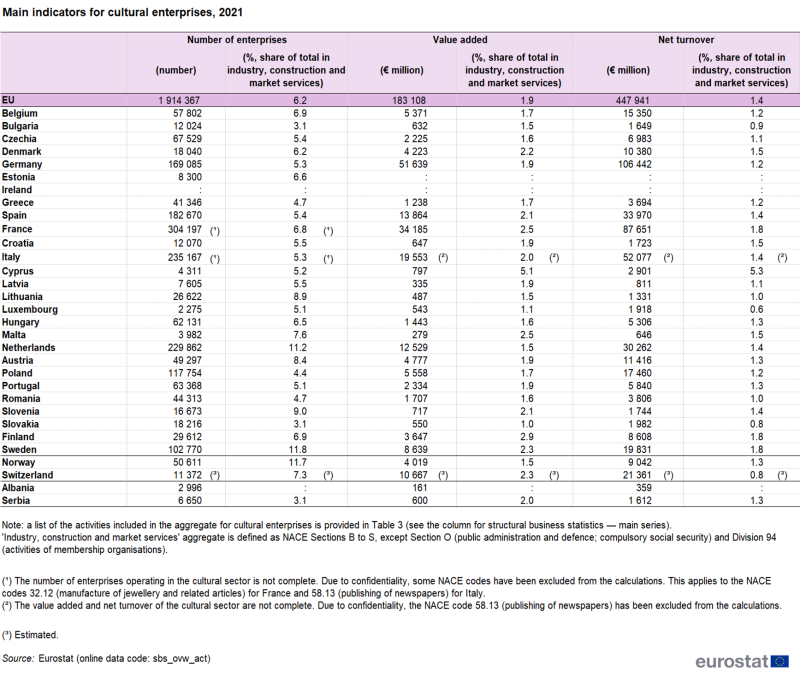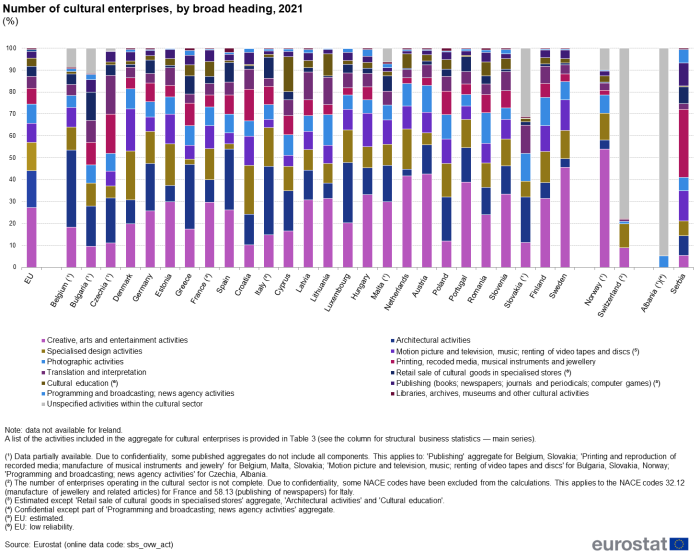Culture statistics - cultural enterprises
Data extracted in December 2023.
Planned article update: March 2025.
Highlights
In 2021, 1.9 million cultural enterprises in the EU generated around € 183 billion value added.
In 2021 most of the EU cultural sector’s value added was generated by small and medium-sized enterprises.
In 2021, a third of the total value added generated in the EU by enterprises operating within cultural domains came from publishing and architectural activities.
Share of cultural enterprises in the total number of enterprises in industry, construction, and market services within national economies, 2021 %
This article presents 2021 statistics on businesses ('enterprises') active in the cultural sector. It forms part of the online publication Culture statistics. Eurostat compiles these data from two distinct sources: structural business statistics (SBS) and business demography (BD).
Full article
Cultural business in the EU: key indicators
In 2021:
- There were 1.9 million cultural enterprises in the EU – 6.2 % of all businesses within the non-financial business economy;
- They generated around € 183 billion of value added – 1.9 % of the non-financial business economy total (see Table ). For comparison, the value added of the cultural sector within the EU was slightly higher than that of the motor trade and repair sector (NACE division 45; € 181 billion);
- The cultural sector’s net turnover was around € 448 billion (total value of income generated) – 1.5 % of the total net turnover generated within the EU’s non-financial business economy;
- A quarter of cultural enterprises in the EU were engaged in creative, arts and entertainment sector;
- Publishing and architecture accounted for a third of the total value added generated by the EU’s cultural sector.
Table 1 highlights the cultural sector’s relative importance (as measured by its share within the non-financial business economy). Based on the number of businesses, the share was particularly high in Sweden (11.8 %) and the Netherlands (11.2 %). By contrast, cultural enterprises accounted for less than 5% of businesses in the non-financial business economies in 5 EU Member States, with the lowest share in Bulgaria and Slovakia (both at 3.1 %).
The highest value added generated by cultural enterprises as a share of the national non-financial business economy was in Cyprus (5.1 %) and Finland (2.9 %). The highest shares in turnover for cultural enterprises were in Cyprus (5.3 %) and Sweden (2.0 %).
Half of all cultural enterprises in the EU (49.7 %) were located in four EU Member States: France, Italy, the Netherlands and Spain. France had the largest share (15.9 %) (enterprises under the NACE code 32.12 are not counted for reasons of confidentiality).
In 2021, Germany accounted for the highest proportion of value added generated by cultural enterprises in the EU (28.2 % of the EU total), followed by France (18.7 %) and Italy (10.7 %). Together, these three countries accounted for 57.5 % of the total value added generated. The same three countries also accounted for 55 % of the EU cultural sector’s turnover.
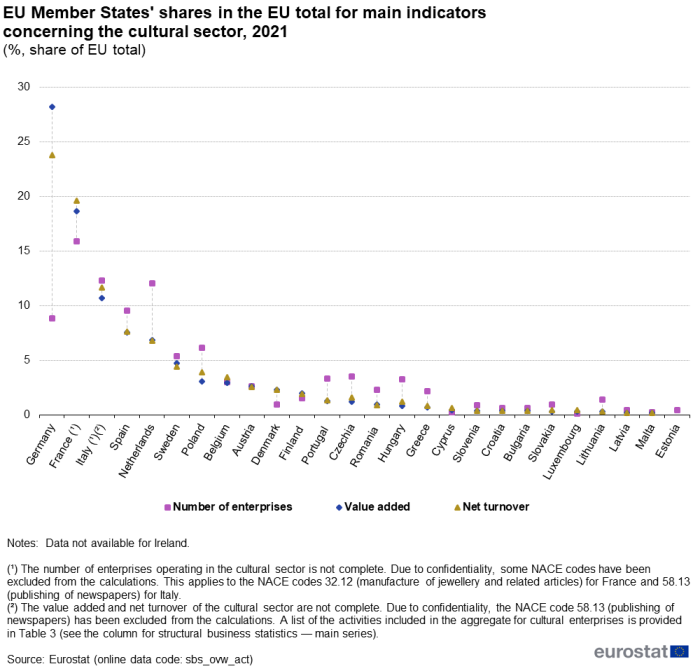
(%, share of EU total)
Source: Eurostat (sbs_ovw_act)
Number of enterprises and value added by category of product
The 21 different economic activities that together form the total cultural aggregate – ’enterprises in the cultural sector’ or ’cultural enterprises’ – are grouped into the following broad headings:
- ’printing and reproduction of recorded media; manufacture of musical instruments and jewellery’ (manufacturing-related cultural activities) – NACE division 18, NACE class 32.12 and NACE group 32.2;
- ’retail sale in specialised stores’ (books; newspapers and stationery; music and video recordings) – NACE classes 47.61, 47.62 and 47.63;
- ’publishing’ (books; newspapers; journals and periodicals; computer games) – NACE classes 58.11, 58.13, 58.14 and 58.21;
- ’motion picture and television, music; renting of video tapes and discs’ – NACE division 59 and NACE class 77.22;
- ’programming and broadcasting; news agency activities’ – NACE division 60 and NACE class 63.91;
- ’architectural activities’ – NACE class 71.11;
- ’specialised design activities’ – NACE group 74.1;
- ’photographic activities’ – NACE group 74.2;
- ’translation and interpretation activities’ – NACE group 74.3;
- ‘cultural education’ – NACE class 85.52;
- ‘creative, arts and entertainment activities’ – NACE division 90;
- ‘libraries, archives, museums and other cultural activities’ – NACE division 91.
In 2021, the highest number of cultural enterprises were involved in creative, arts, and entertainment activities.
Of all cultural enterprises operating in the EU in 2021, the largest number was involved in ‘creative, arts, and entertainment activities’ (27.2%) – one of the NACE codes newly included in structural business statistics. In addition, two other broad headings accounted for a double-digit share of the total number of cultural enterprises (see Figure 2): ‘architectural activities’ (17.0%) and ‘specialised design activities’ (12.8%).
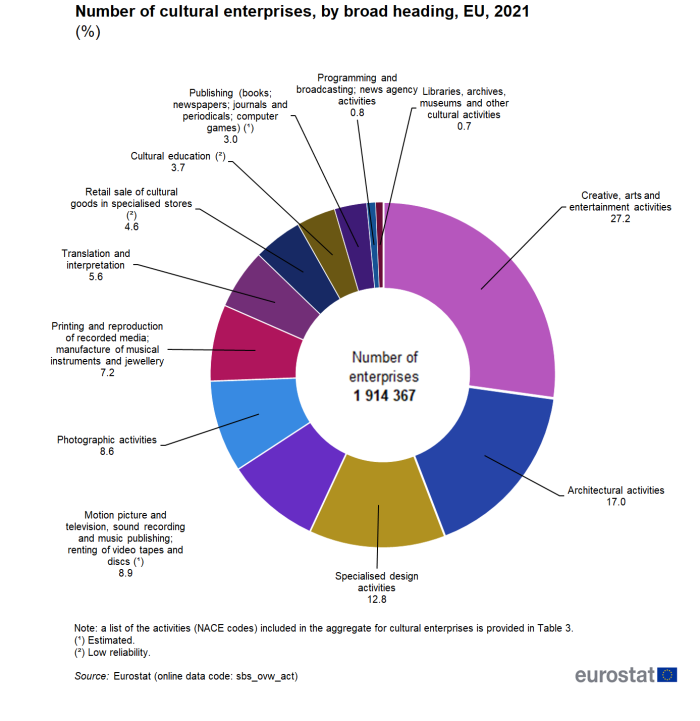
(%)
Source: Eurostat (sbs_ovw_act)
The value added generated by different parts of the cultural sector does not correlate with the number of businesses operating within them.
In 2021, though ‘creative, arts and entertainment’ was the biggest area in terms of the number of businesses, Figure 3 shows that the highest value added was generated by:
- ’publishing of books; newspapers; journals and periodicals; computer games’ (16.0 %, data partially available, the aggregate does not contain all components);
- ’architectural activities’ (15.9 %);
- ‘printing and reproduction of recorded media; manufacture of musical instruments and jewellery’ (15.2 %) and
- ’programming and broadcasting; news agency activities’ (10.2 %).
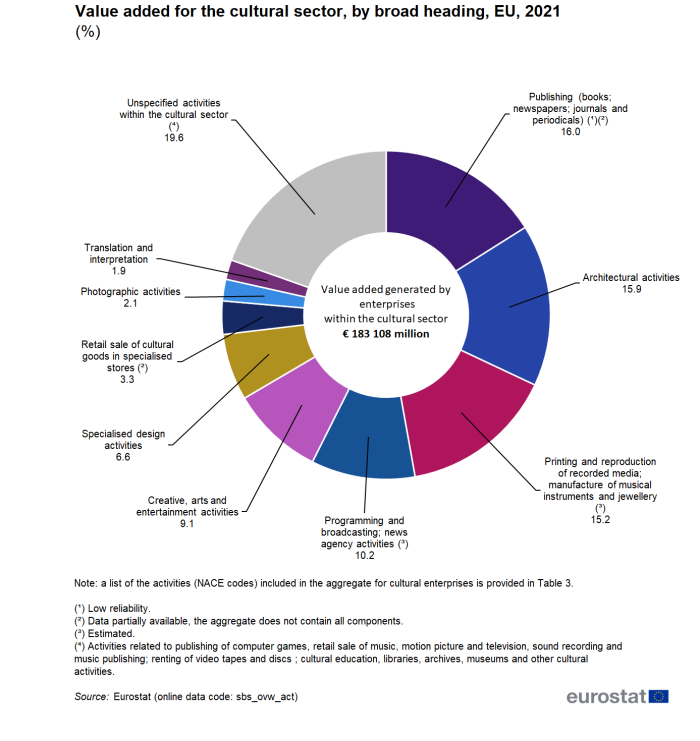
(%)
Source: Eurostat (sbs_ovw_act)
Among all the types of cultural activities, ’programming and broadcasting; news agency activities’ stood out for the economic value it generated in proportion to the number of enterprises. With just 0.8 % of the total number of cultural enterprises, it generated over 10 % of the sector’s total value added in the EU (€ 29 billion).
By contrast, ’photographic activities’, accounting for 8.6 % of enterprises in the cultural sector, generated 2.1 % of the cultural sector’s total value added (€ 4 billion).
The data at country level show that in 2021, ‘creative, arts and entertainment activities’ had the largest share of cultural enterprises in 14 out of 26 EU Member States for which data were available (headed by Sweden, where 45.5 % of all cultural enterprises were active in that field). ‘Architectural activities’ constituted the largest group of business activities in the cultural sector in 10 EU Member States, led by Belgium, where it accounted for 35.2 % of all cultural enterprises. Cultural enterprises involved in ‘specialised design activities’ were the most numerous in Denmark (22.5 %) and Croatia (22.4, see Figure 4).
Figure 5 gives a similar national breakdown by broad cultural headings based on value added generated. In 2021, in 15 of the 25 EU Member States for which data were available, manufacturing-related cultural activities accounted for the largest share of value added (’printing and reproduction of recorded media; manufacture of musical instruments and jewellery’). The share was highest at 37.2 % in Malta.
In 4 EU Member States (headed by Cyprus, 74.9 %) ’publishing (books; newspapers; journals and periodicals; computer games)’ generated the highest value added; in 4 others (headed by Luxembourg, 38.6 %) it was ‘architectural activities’. In France, ‘programming and broadcasting; news agency activities’ had the largest share (20.7 %) and in the Netherlands ‘creative, arts and entertainment activities’ (18.4 %).
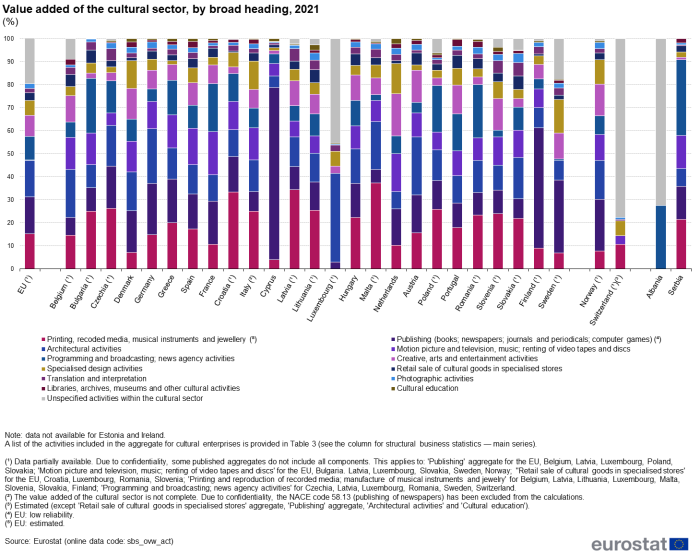
(%)
Source: Eurostat (sbs_ovw_act)
How big are the enterprises in the cultural sector?
Small and medium-sized enterprises (SMEs) are essential to the EU economy. Driving job creation and economic growth, they play a prominent role in EU policy developments. SMEs (businesses employing fewer than 250 people) tend to dominate in several branches of the EU’s cultural sector.
Table 2 shows the indicators presented above further broken down by business size (defined by the number of people employed). In 2021, SMEs employed most of the EU’s workers across the various economic activities relating to culture. The only exception was in programming and broadcasting, where over two thirds of people (68.7 %) were employed by large companies. Furthermore, most EU workers in photographic activities (88.3 %), specialised design activities (80.5 %), translation and interpretation activities (79.1 %) and creative, arts and entertainment activities (79.0 %) were employed by micro enterprises (employing fewer than 10 people).
Additionally, in 2021 SMEs generated most of the EU cultural sector’s value added. This applies to all branches for which data are available, except programming and broadcasting activities.
Note: in this section, the aggregate used for cultural activities differs from that used above for the main series of SBS (see Table 3 in the Data sources section of this article).
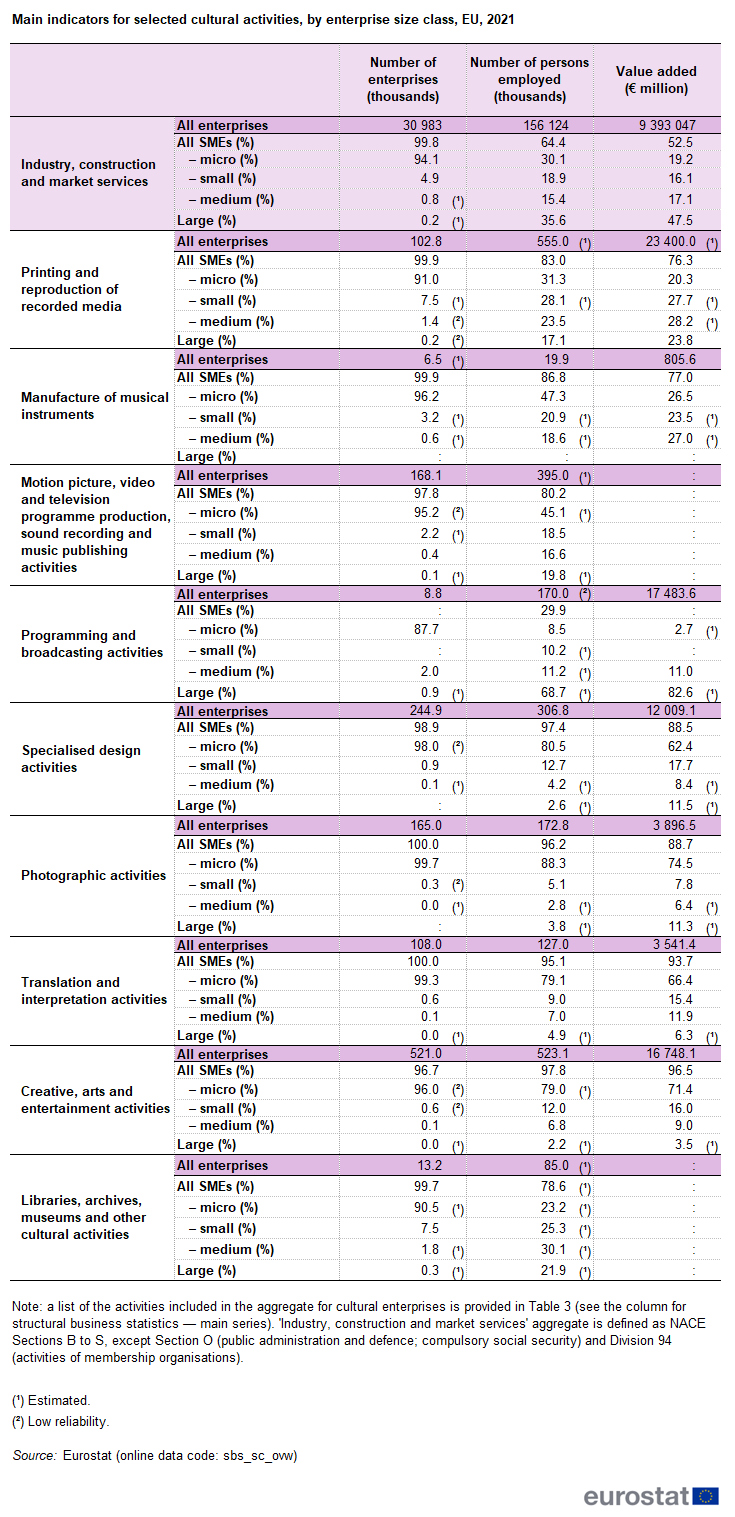
Source: Eurostat (sbs_sc_ovw)
Which cultural sectors see the most frequent business start-ups (and closures)?
Business demography statistics include indicators such as business birth and death rates. This information is used to analyse demographic trends, reflecting the dynamism with which economic structures adapt to changing market conditions (the definitions of the indicators analysed are available below in the ‘Data sources’ section of the article).
For the purpose of analysing cultural activities, business demography statistics are only compiled for a small subset of activities within the service sector (see Table 3 for a complete list).
In the field of specialised design activities, about one in six businesses was newly born in 2021.
Figure 6 provides a summary of enterprise birth and death rates for a selection of cultural activities along with their corresponding employment shares. In 2021, the EU enterprise birth rate was 10.9 % for services within the business economy (NACE sections G to S, excluding Section O ‘public administration and defence; compulsory social security’ and Division 94 ‘activities of membership organisations’), indicating that for every 100 active enterprises, about 11 were newly born in the reference period. Out of 8 selected cultural activities, 4 reported an enterprise birth rate higher than the average for all services in the business economy. The highest enterprise birth rate was recorded for ’specialised design activities’ (17.9 %) (data not available for ’renting of video tapes and disks’, data for ‘architectural activities’ refer to 2020).
At the same time, the EU enterprise death rate for services in the business economy was 8.6 %, 2.3 percentage points lower than the enterprise birth rate. 5 of the 8 listed cultural activities recorded higher enterprise death rates than the average of services within the business economy. In the cultural sector, ‘specialised design activities’ had the highest rate (10.5 %), and ‘programming and broadcasting’ the lowest (5.7 %).
Among the activities for which data are available, architectural activities had a higher death rate than birth rate. In 2021, start-ups employed 11% of workers in ‘specialised design activities.’ This was four times the average employment rate for new businesses across the entire service sector in the EU (2.7 %). Furthermore, within the cultural sector, new companies accounted for 9 % of total workers in photography and approximately 7 % in both ‘creative arts and entertainment activities’ and ‘translation and interpretation activities.’ Over 5 % of the employees in these four fields were employed in companies that ceased trading in 2021. This value was considerably above the average for companies that ceased trading in the service sector as a whole in the EU (2.4 %).
In the field of ‘specialised design activities’ the percentage of people working in companies that closed in 2021 was significantly lower than the percentage in start-ups. Conversely, for ‘architectural activities’ and ‘translation and interpretation activities,’ the percentage of people employed in companies that closed was significantly higher than those working in new companies. It was also higher for ‘libraries, archives, museums and other cultural activities’ and ‘programming and broadcasting activities’ though the difference was less pronounced.
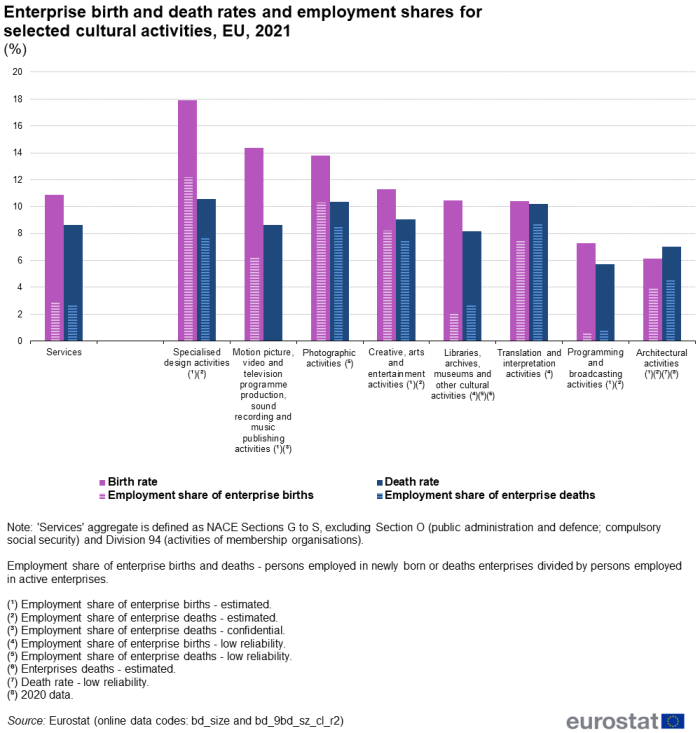
(%)
Source: Eurostat (bd_size) and (bd_9bd_sz_cl_r2)
In 2021, the employment share of start-ups in ’specialised design activities’ was higher than the average for all services in the business economy in every EU Member State for which data are available (no figures are available for Slovenia), with the highest rate recorded in France (19.9 %). In France, the Netherlands, Luxembourg and Ireland, this share was over five times the average for all services in the business economy.
The employment share for new businesses in ’creative, arts and entertainment activities’ was higher than the average for services in the business economy in 24 out of 25 countries with available data. Latvia had the highest rate (17.3 %). Lithuania was the only EU country where the employment share in new businesses was lower in ‘creative, arts, and entertainment activities’ compared to the services average.
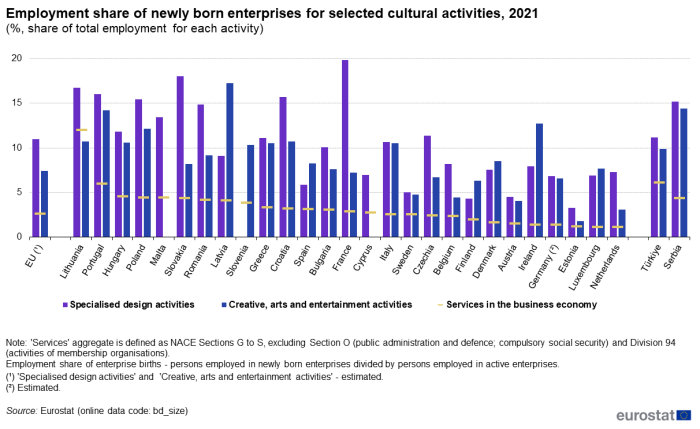
(%, share of total employment for each activity)
Source: Eurostat (bd_size)
Source data for tables and graphs
Coverage and data sources
Comprehensive details of the NACE codes in this article are given in Table 3.
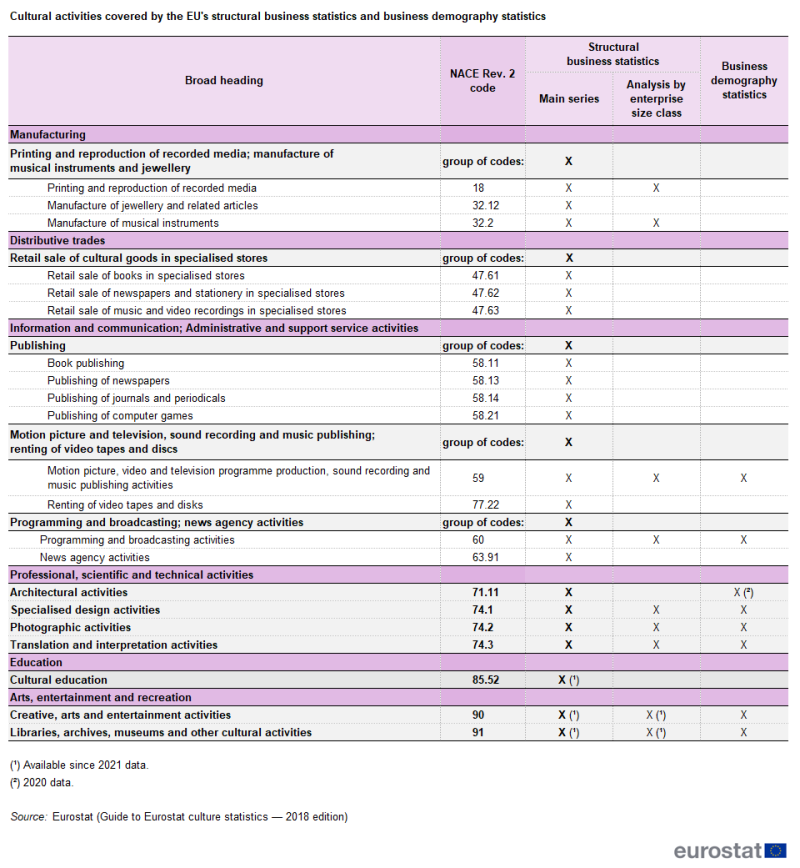
Source: Eurostat, Guide to Eurostat culture statistics, 2018 edition
Changes to the data
The article presents 2021 final data on cultural enterprises for the first time since the implementation of the Regulation 2019/2152 on European Business Statistics (EBS).
The EBS Regulation extended statistical coverage to the following NACE codes:
- Division 90 (Creative, arts, and entertainment activities)
- Division 91 (Libraries, archives, museums, and other cultural activities)
- Class 85.52 (Cultural education).
With this extension, the main data set allows for more detailed statistical analysis.
In addition to these improvements, structural business statistics (SBSs) and business demography (BD) datasets have been organised into new tables from 2021 onward. Historical data remain accessible to users under the common Eurobase code ‘cult_ent_h’.
While the EBS Regulation allows for insights into enterprises operating in the cultural sector, the availability of statistical data on economic activities still varies depending on the data source (SBS or BD) and the scope of analysis.
Eurostat compiles these data from two distinct sources:
Both of these sources are restricted to market-oriented activities.
Note: the activity coverage of culture-related enterprises differs between structural business statistics and business demography statistics – see Table 3 for more details.
Structural business statistics
SBS cover industry, construction, trade and (market) services, as defined by the statistical classification of economic activities in the European Community (NACE). This classification allows for a detailed sectoral breakdown of business activities. The information is available for a broad range of structural indicators (including data for the number of businesses, the number of people employed, turnover and value added) and can also be broken down by business size. The version of NACE currently used in the European statistical system is NACE Rev. 2, implemented from 2008 onwards.
SBS describe the structure, conduct and performance of businesses within the non-financial business economy (NACE sections B to S, except public administration and defence, compulsory social security, and activities of membership organisations). Starting with the reference year 2021, Structural Business Statistics are compiled under EU regulation 2019/2152 and its implementing act, EU regulation 2020/1197. The data presented for the cultural sector aggregate cover 21 different economic activities (at different levels of NACE) – see Table 3 for the composition of this aggregate for the main series of SBS.
Within the context of SBS, the following definitions apply:
- The enterprise as defined in Council Regulation (EEC) No 696/93 is the smallest combination of legal units that is an organizational unit producing goods or services, which benefits from a certain degree of autonomy in decision-making, especially for the allocation of its current resources. An enterprise carries out one or more activities at one or more locations. An enterprise may be a sole legal unit.
The term ‘enterprise’ in the article refers to the number of active enterprises.
- Number of active enterprises is the number of all statistical units which at any time during the reference period were ‘enterprises’, as defined in Council Regulation (EEC) No 696/93, and active during the same reference period. A statistical unit is considered to have been active during the reference period, if in said period it either realized positive net turnover or produced outputs or had employees or performed investments.
- The number of employees and self-employed persons (the number of persons employed) is the sum of the Number of employees and Number of self-employed persons. The ‘number of employees’ represents the average number of persons who were, at some time during the reference period, employees of the statistical unit. The ‘number of self-employed persons’ is the average number of persons who were at some time during the reference period the sole owners or joint owners of the statistical unit in which they work. Family workers and outworkers whose income is a function of the value of the outputs of the statistical unit are also included.
- Net turnover comprises all income generated during the reference period through the regular activities of the statistical unit and is presented after deducting all price reductions, discounts, and rebates granted by it. Excluded from net turnover are:
- all taxes, duties or levies linked directly to revenue;
- any amounts collected on behalf of any principal, if the statistical unit is acting as an agent in its relationship with said principal;
- all income not arising in the course of ordinary activities of the statistical unit. Usually, these types of income are classified as ‘Other (operating) income’, ‘Financial income’, ‘Extra-ordinary income’ or under a similar heading, depending on the respective set of generally accepted accounting standards used to prepare the financial statements.
- Value added is a composite indicator of net operating income, adjusted for depreciation, amortization and employee benefits, all components being recognized as such by the statistical unit during the reference period. Its value is given by the formula:
- net turnover (+)
- income from product- or turnover-related subsidies (+)
- capitalized output (+)
- change in stock of goods (±)
- total purchases of goods and services (-).
Alternatively, it can be calculated from the gross operating surplus by adding personnel costs.
SBS may be broken down by business size-class for analytical purposes, as follows:
- Small and medium-sized enterprises (SMEs) employing 1 to 249 people, composed of:
- micro enterprises with less than 10 people employed;
- small enterprises with 10 to 49 people employed;
- medium-sized enterprises with 50 to 249 people employed.
They should also have an annual turnover of up to €50 million, or a balance sheet total of no more than € 43 million.
- Large enterprises with 250 or more people employed.
Business demography statistics
Business demography statistics cover information for business births and deaths, as well as indicators relating to survival rates or the impact newly founded businesses have on employment. These statistics are usually drawn from business registers, although some EU Member States seek to increase data availability by integrating alternative sources.
Within the context of business demography statistics, the following definitions apply:
- An active enterprise - an enterprise is considered to have been active if, in the considered period, it either realized positive net turnover or produced outputs or had employees or performed investments.
- An enterprise birth refers to a count of newly established enterprises registered in the relevant population in the business register, adjusted for errors. A birth amounts to the creation of a combination of production factors with the restriction that no other enterprises are involved in the event. Births do not include entries into the population due to mergers, break-ups, split-off or restructuring of a set of enterprises. It does not include entries into a sub-population resulting only from a change of activity.
- The enterprise birth rate for a given reference period (usually one calendar year) is defined as the number of enterprise births, expressed as a percentage of the total number of active enterprises.
- An enterprise death refers to a count of the number of deaths of enterprises registered to the population concerned in the business register corrected for errors. A death amounts to the dissolution of a combination of production factors with the restriction that no other enterprises are involved in the event. Deaths do not include exits from the population due to mergers, take-overs, break-ups or restructuring of a set of enterprises. It does not include exits from a sub-population resulting only from a change of activity.
- The enterprise death rate for a given reference period (usually one calendar year) is defined as the number of enterprise deaths, expressed as a percentage of the total number of active enterprises.
Context
Culture is one of Europe’s greatest assets: it is a source of values and identity and creates a sense of belonging. It also contributes to well-being, social cohesion and inclusion. The cultural and creative sectors are also sources of economic growth, new jobs and international trade.
This is why culture is becoming more important in the EU. In line with Article 167 of the Treaty of Lisbon, the EU ’shall contribute to the flowering of the cultures of the Member States, while respecting their national and regional diversity and at the same time bringing the common heritage to the fore’.
The EU supports these objectives through the Creative Europe programme and a number of policy actions set out in the work plan for culture (2023-2026), setting the main priorities for European cooperation in cultural policymaking: empowering the cultural and creative sectors (CCS); enhancing cultural participation and the role of culture in society; unleashing the power of culture; and strengthening the cultural dimension of the EU external relations. According to the work plan, implementation should also be supported by optimised use of quality data and statistics.
Direct access to
- Culture (articles on culture statistics)
- Structural business statistics overview
- Business demography statistics
- Sport (articles on sport statistics)
- Culture statistics, see:
- Enterprises in cultural sectors (cult_ent)
- enterprises by detailed NACE Rev.2 activity and special aggregates (bookmark of sbs_ovw_act)
- enterprise statistics by size class and NACE Rev.2 activity (from 2021 onwards) (bookmark of sbs_sc_ovw)
- business demography by size class and NACE Rev. 2 activity (bookmark of bd_size)
- enterprises in cultural sector – historical data (cult_ent_h)
- Guide to Eurostat culture statistics — 2018 edition
- European statistical system network on culture (ESSnet-Culture final report (2012))
- Enterprises in cultural sectors (ESMS metadata file — cult_ent_esms)
- Structural business statistics (ESMS metadata file — sbs_esms)
- Business demography (ESMS metadata file — bd_esms)
- Regulation (EU) No 2152/2019 of the European Parliament and of the Council of 27 November 2019 on European business statistics
- Commission Implementing Regulation (EU) 2020/1197 of 30 July 2020 laying down technical specifications and arrangements pursuant to Regulation (EU) 2019/2152 of the European Parliament and of the Council on European business statistics repealing 10 legal acts in the field of business statistics
- Regulation (EU) No 2021/818 of the European Parliament and of the Council of 20 May 2021 establishing the Creative Europe Programme (2021 to 2027) and repealing Regulation (EU) No 1295/2013
- European Council Work Plan for Culture (2023-2026)
- European Council Work Plan for Culture (2019-2022)
- Communication from the Commission to the European Parliament, the Council, the European Economic and Social Committee and the Committee of the Regions on a European agenda for culture in a globalising world (COM(2007) 242)
